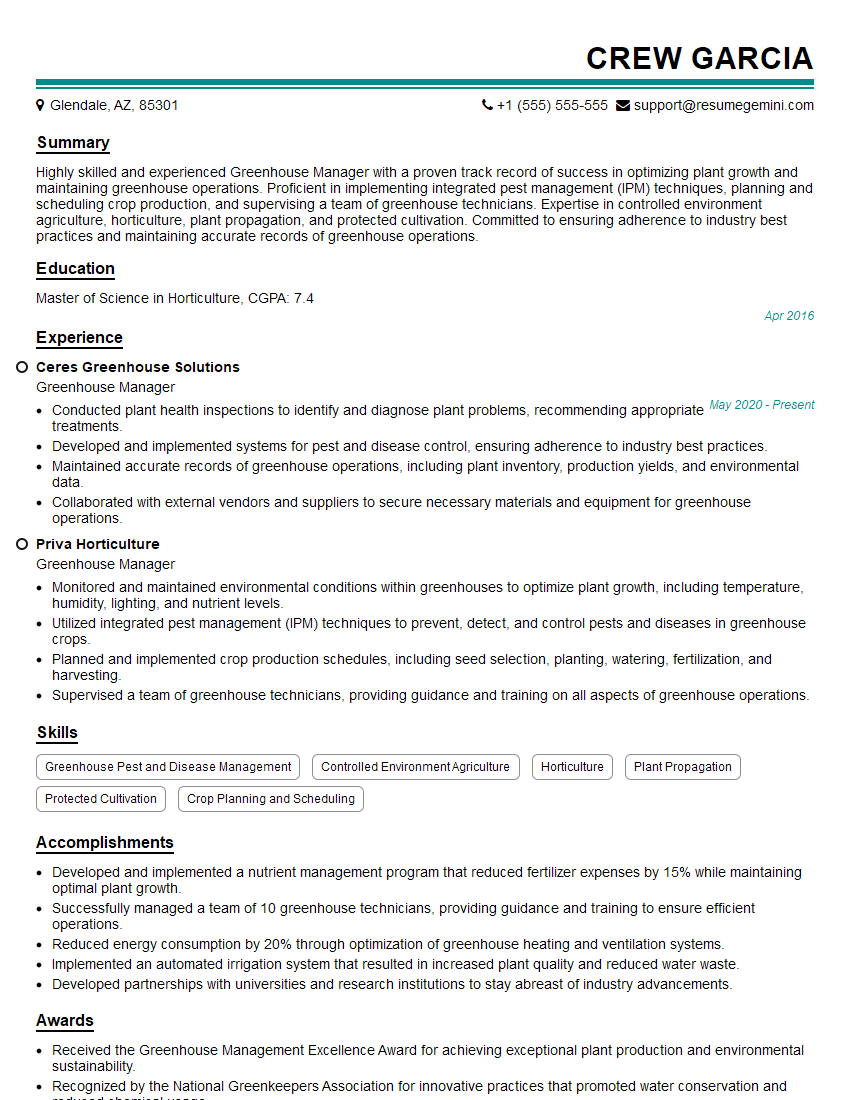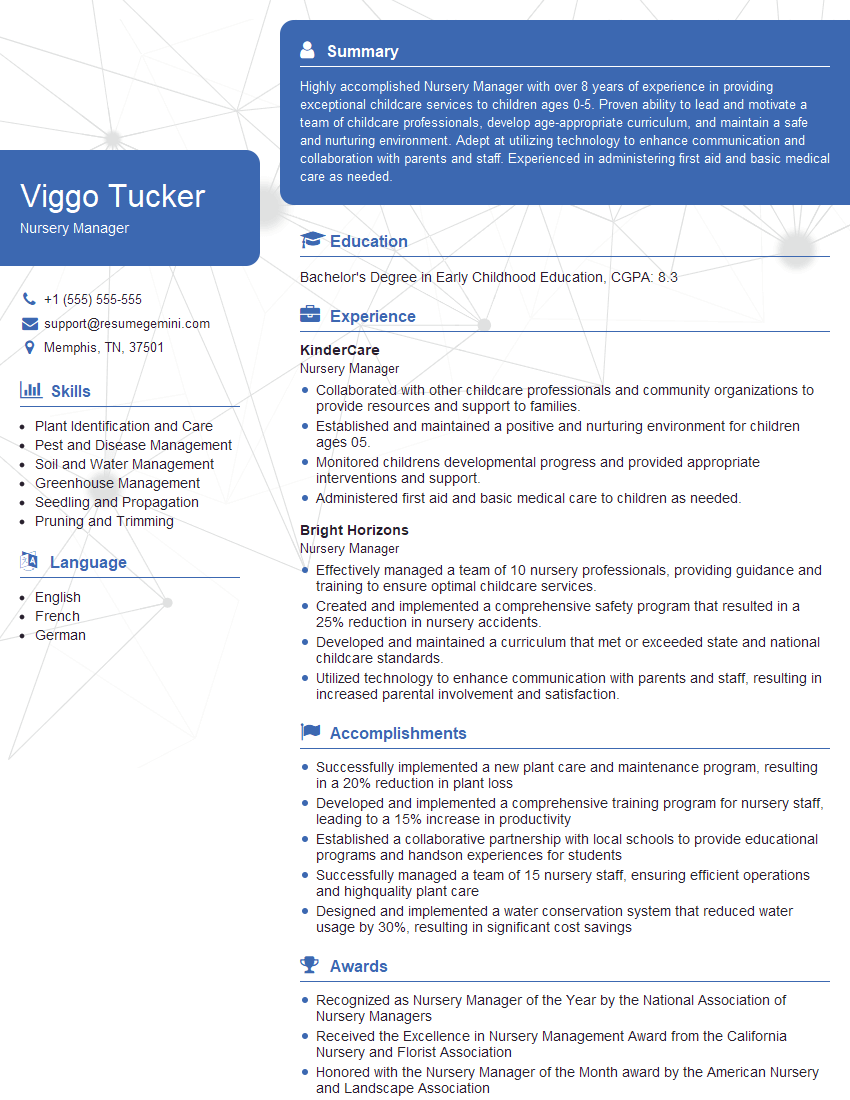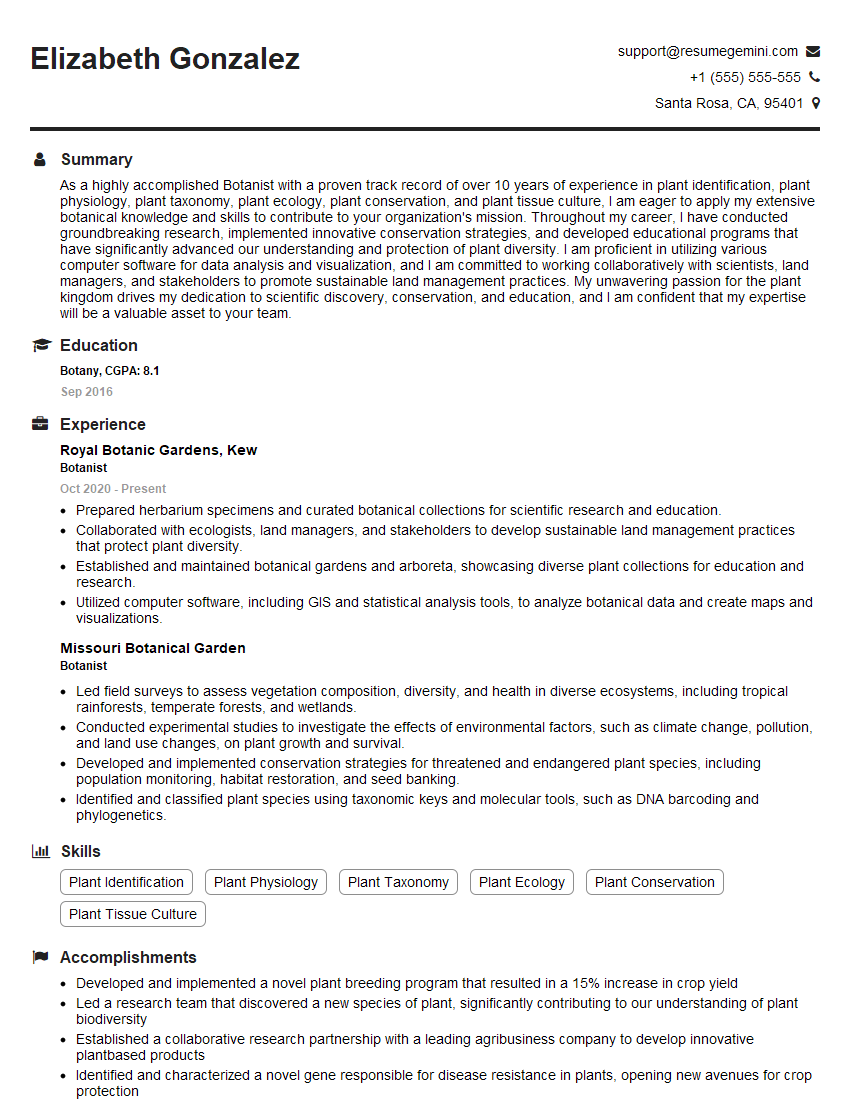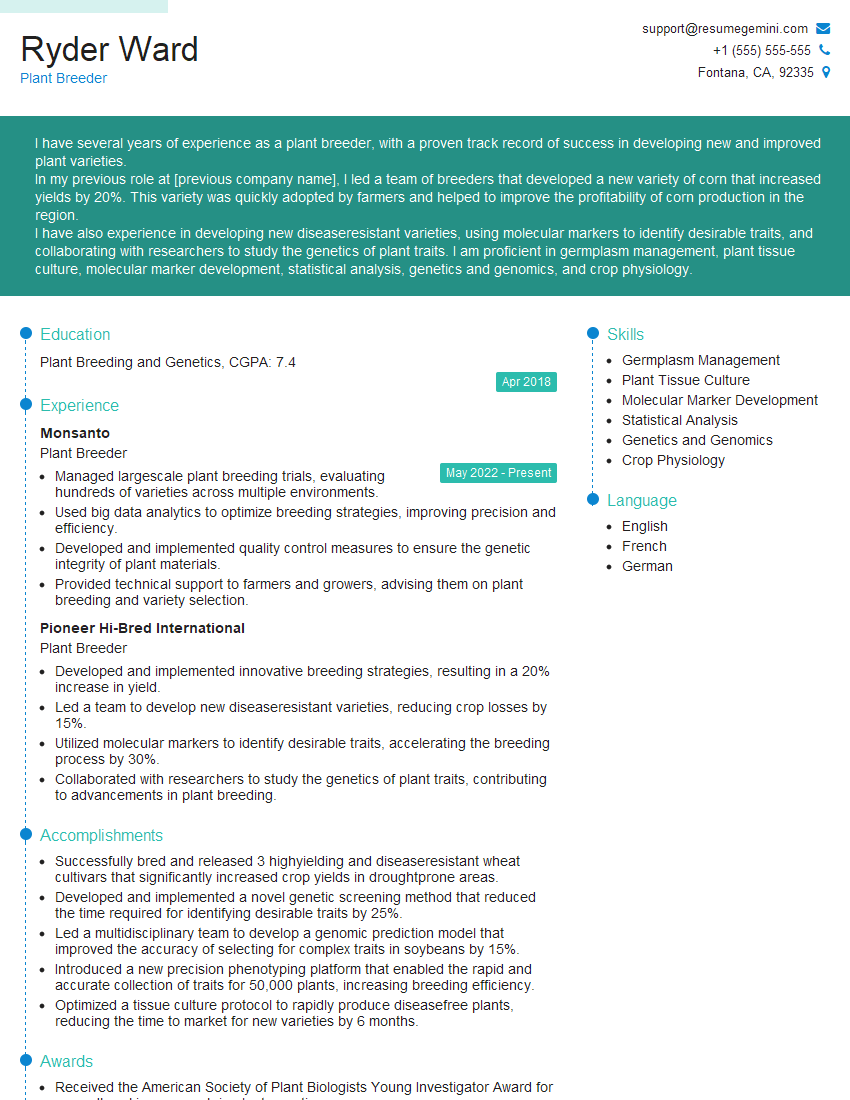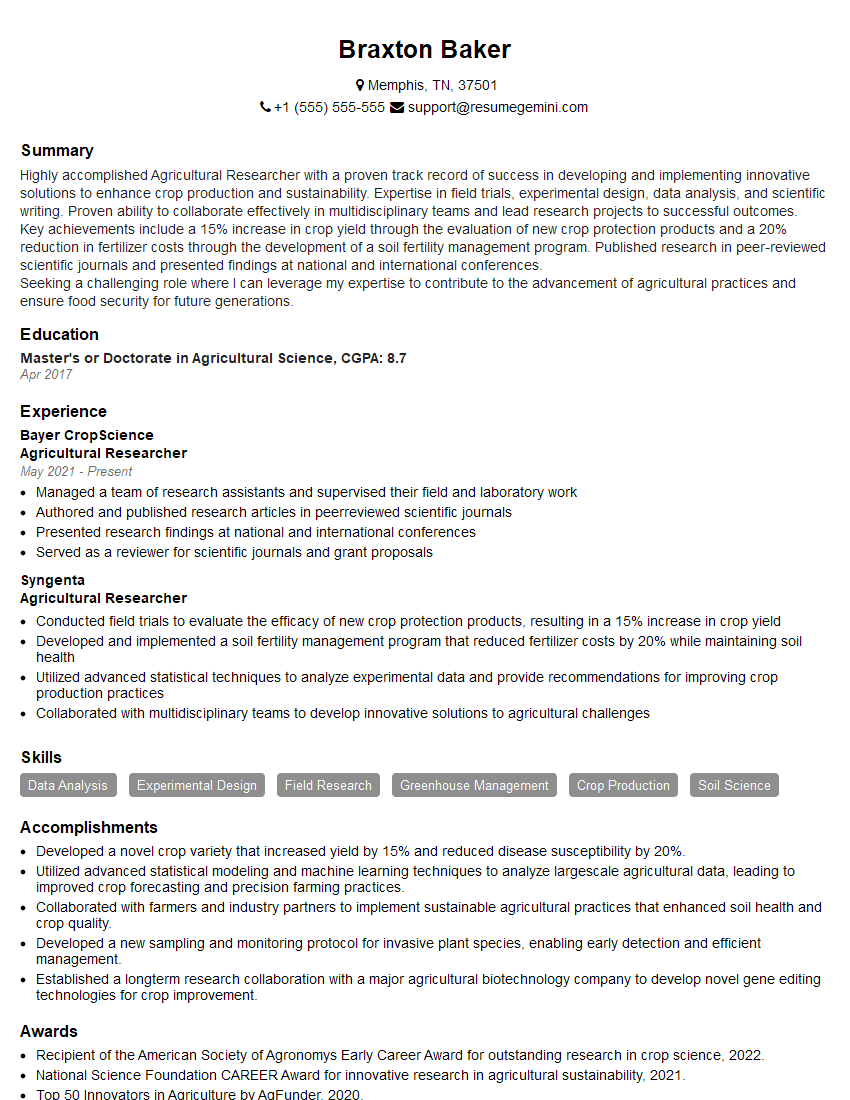The right preparation can turn an interview into an opportunity to showcase your expertise. This guide to Understanding of Bulb Life Cycle interview questions is your ultimate resource, providing key insights and tips to help you ace your responses and stand out as a top candidate.
Questions Asked in Understanding of Bulb Life Cycle Interview
Q 1. Describe the stages of a typical bulb life cycle.
The bulb life cycle, while varying slightly depending on the specific species, generally follows these key stages:
- Vegetative Growth: After planting, the bulb sends out roots and shoots. Leaves develop, photosynthesizing to produce energy for the bulb’s growth and the development of the flower bud.
- Flower Initiation: As the bulb matures, it begins to form a flower bud within its structure. This is a crucial stage where the plant commits its energy towards flowering.
- Flowering: The flower emerges from the bulb, showcasing its unique characteristics – color, shape, and fragrance – and attracts pollinators.
- Seed Production (in some cases): Once pollination occurs, the flower will form seeds, allowing for sexual reproduction. Note that not all bulbs rely on seed production for propagation.
- Senescence: After flowering, the above-ground parts of the plant die back, but the bulb remains underground. It has now stored energy for future growth.
- Dormancy: The bulb enters a period of dormancy, a resting phase crucial for its survival and future development. During this period, metabolic activity is reduced to a minimum, conserving energy. The length of the dormancy period varies depending on the species.
- Renewal: The cycle begins again when conditions are favorable (usually the arrival of spring or a suitable rainy season), the bulb resumes growth, and the process starts over.
Think of it like a plant’s annual ‘sleep’ and ‘wake-up’ cycle. The bulb essentially saves all the energy and nutrients for the following season.
Q 2. Explain the role of dormancy in bulb development.
Dormancy is a critical stage in the bulb life cycle, acting as a survival mechanism during unfavorable conditions. It allows the bulb to withstand periods of cold, drought, or other environmental stressors that might otherwise kill the plant. During dormancy, the bulb’s metabolic activity slows dramatically, conserving energy and resources stored within its layers. This stored energy is then used to fuel the next season’s growth and flowering. Think of it as hibernation for the bulb; it’s the period of rest and rejuvenation that enables it to flourish again.
Without a period of dormancy, the bulb would likely exhaust its resources and die. Different bulbs have different dormancy needs, some requiring a cool, dry period, while others might need a warm, moist period. Understanding these requirements is key to successful bulb cultivation.
Q 3. What environmental factors influence bulb growth?
Several environmental factors significantly influence bulb growth and development:
- Temperature: Bulbs require specific temperature ranges for different stages of their life cycle, influencing germination, flowering, and dormancy.
- Moisture: Adequate water availability is essential, especially during periods of active growth. However, excess water can lead to rot and fungal diseases.
- Light: Sufficient sunlight is crucial for photosynthesis, providing energy for growth and flowering. The amount of light needed varies across species.
- Soil Conditions: Well-drained, nutrient-rich soil is ideal. Soil pH also plays a role, as different bulbs prefer different levels of acidity or alkalinity.
- Nutrient Availability: The presence of essential nutrients like nitrogen, phosphorus, and potassium greatly affects the bulb’s size, flowering intensity, and overall health.
For instance, tulips thrive in well-drained soil with ample sunlight, while daffodils are more tolerant of partial shade. Understanding these specific needs is vital for successful bulb cultivation.
Q 4. How does temperature affect bulb flowering?
Temperature plays a crucial role in bulb flowering. Many bulbs require a period of chilling (vernalization) before they can flower. This chilling period mimics the winter conditions and signals to the bulb that it’s time to begin its flowering process. The specific temperature requirements and duration of the chilling period vary among species.
For example, some tulip varieties need several weeks of temperatures close to freezing before they can flower. Without this chilling period, they may not flower at all or will flower poorly. Conversely, high temperatures during the crucial flowering period might lead to premature flowering or reduced bloom quality. Proper temperature management is thus essential for optimal flowering.
Q 5. Discuss the importance of light in bulb development.
Light is essential for bulb development, primarily because it fuels photosynthesis. During the vegetative growth phase, bulbs need sufficient light to produce carbohydrates (sugars) through photosynthesis. These carbohydrates are vital for building up the bulb’s size, storing energy for flowering, and maintaining overall health. Light also influences the timing and intensity of flowering.
Insufficient light can lead to weak, leggy growth, reduced flowering, or even prevent flowering altogether. The specific light requirements vary widely between different bulb species. Some bulbs prefer full sun, while others tolerate or even prefer partial shade. In horticulture, light intensity and duration are carefully managed to optimize bulb growth and flowering.
Q 6. What are the key nutrient requirements for optimal bulb growth?
Optimal bulb growth depends on a balance of essential nutrients. While the specific requirements vary slightly based on the species, the key macronutrients are:
- Nitrogen (N): Crucial for leafy green growth. An excess of nitrogen can delay flowering and make the plant more susceptible to diseases.
- Phosphorus (P): Essential for root development, flowering, and seed production. Phosphorus deficiency can lead to stunted growth and poor flowering.
- Potassium (K): Improves overall plant health, strengthens stems, and enhances disease resistance. Potassium deficiency can lead to weak stems and poor flower quality.
In addition to these macronutrients, micronutrients like iron, zinc, and manganese are also needed in smaller amounts but are still crucial for healthy bulb development. Proper fertilization, often involving a balanced NPK (Nitrogen, Phosphorus, Potassium) fertilizer, is therefore crucial for maximizing bulb yields and quality.
Q 7. Explain the process of bulb propagation.
Bulb propagation involves the multiplication of bulbs to create more plants. Several methods exist:
- Offset Bulbs (Bulblets): Many bulbs produce smaller bulbs (bulblets) around the mother bulb. These can be carefully separated and planted to produce new plants. This is a common propagation method for many lilies and daffodils.
- Scales: Some bulbs can be propagated from scales (the individual layers of the bulb). These scales are planted under specific conditions to stimulate the development of new bulblets.
- Seed Propagation: This involves collecting seeds from the spent flower and germinating them. This method is typically slower and more complex than vegetative propagation but allows for the creation of new cultivars.
The choice of propagation method depends on the bulb species and the desired outcome. For example, offset bulbs are a relatively simple and efficient method for increasing the number of plants, while seed propagation is used more often for breeding new varieties.
Q 8. Describe different methods of bulb storage.
Proper bulb storage is crucial for maintaining their viability and ensuring a successful planting season. The methods employed depend largely on the type of bulb and the length of storage required.
- Cool, Dry, and Dark Storage: This is the most common method. Bulbs should be stored in a cool, dark, and well-ventilated area, ideally between 35-45°F (2-7°C). Think of a basement or a refrigerator’s crisper drawer (avoid storing them near fruits that release ethylene gas, which can hasten deterioration). Bulbs should be spread out in a single layer to promote airflow and prevent rot.
- Mesh Bags or Containers with Ventilation: Avoid plastic bags which trap moisture, leading to mold. Use mesh bags or containers with adequate ventilation to allow for air circulation.
- Treating with Fungicides (Optional): For long-term storage, a light dusting with a fungicide can help prevent fungal diseases. Always follow the product’s instructions carefully.
- Specific Requirements: Some bulbs, like tulips, benefit from pre-chilling before planting, requiring a period in cold storage (closer to 35-40°F (2-4°C)) to simulate winter conditions.
For example, storing daffodil bulbs in a mesh bag in a cool, dark corner of the basement is a common and effective practice. Conversely, storing gladiolus corms might require slightly warmer temperatures (around 50°F (10°C)) and more careful monitoring for sprouting.
Q 9. How do you prevent diseases and pests in bulb cultivation?
Preventing diseases and pests in bulb cultivation is paramount for a successful harvest. A multi-pronged approach is typically necessary.
- Disease Prevention: This starts with selecting high-quality, disease-free bulbs. Before planting, you can treat bulbs with a fungicide, ensuring you follow the manufacturer’s instructions precisely. Proper spacing during planting helps improve airflow, reducing the risk of fungal diseases. Rotating crops in your garden prevents the buildup of disease-causing organisms in the soil.
- Pest Control: Many pests target bulbs both in the ground and in storage. This includes nematodes, slugs, and mice. Inspecting bulbs before planting can help identify and remove any infested ones. Using preventative methods, such as covering beds with mesh to deter slugs, is vital. In some cases, targeted pesticides might be necessary, but only use those approved for bulb crops and follow instructions carefully. Biological control methods, like introducing beneficial nematodes, offer a sustainable alternative for pest management.
- Hygiene: Maintaining a clean and disease-free growing environment is crucial. Remove any diseased plants immediately to prevent the spread of infection. Clean your tools and equipment to avoid contaminating healthy bulbs.
For instance, using a fungicide dip on tulip bulbs before planting reduces the risk of gray mold, a common disease. Similarly, using diatomaceous earth around the base of plants can deter slugs from damaging bulbs.
Q 10. What are the signs of a healthy bulb?
A healthy bulb exhibits several key characteristics that indicate its vitality and potential for growth. Identifying these signs is critical for selecting good planting material.
- Firmness: A healthy bulb feels firm and solid, without any soft or mushy spots. A soft bulb is likely rotten.
- Weight: A heavy bulb for its size usually indicates it’s well-hydrated and full of stored energy. This is more evident in larger bulbs like dahlias.
- Appearance: Look for clean, unblemished outer layers (tunics, if applicable). Avoid bulbs with cuts, bruises, or signs of mold or discoloration. The color should be characteristic of the particular bulb type – no unusual changes.
- Roots (if present): If you’re inspecting bulbs before planting, healthy roots should be well-formed and show no signs of disease or damage.
- Absence of Pests: Check for signs of infestation – borers, pests, etc.
For example, a firm, heavy onion bulb with intact outer layers and no discoloration is a good indication of a healthy planting choice. A tulip bulb with firm scales and a healthy color would signify its readiness for planting.
Q 11. Explain the difference between different types of bulbs (e.g., tunicate vs. non-tunicate).
Bulbs are broadly categorized into tunicate and non-tunicate based on the presence and nature of their outer protective layers.
- Tunicate Bulbs: These bulbs have a dry, papery outer layer (the tunic) that protects the inner scales. Examples include onions, garlic, and tulips. The tunic provides additional protection against dehydration and disease. Think of it as a natural armor.
- Non-Tunicate Bulbs: These bulbs lack a protective tunic; their scales are fleshy and directly exposed. Examples include lilies and daffodils. These bulbs often require more careful handling during storage to prevent dehydration and damage.
The difference affects storage and handling practices. Tunicate bulbs generally store better and are more resistant to damage during handling because of their natural protection.
Q 12. How do you determine the maturity of a bulb?
Determining bulb maturity is crucial for ensuring optimal quality and yield. The signs of maturity vary depending on the specific bulb type but generally include:
- Leaf and Stem Changes: For most bulbs, the foliage will start to yellow and die back as the bulb matures. This signifies that the plant has transferred its stored energy to the bulb.
- Bulb Size and Firmness: Mature bulbs will have reached their full size and will feel firm to the touch. They’ll be plump and heavy.
- Flowering (for flowering bulbs): The flower stem will naturally die back after the flowering period, signaling the bulb has finished its reproductive cycle. If growing bulbs solely for planting, removing flowers helps direct the bulb’s energy towards its development.
- Bulb Feel: Some bulbs will be quite firm, while others will exhibit a slightly softer texture towards maturity. It’s important to understand the specific texture of the mature bulb for each type.
For example, with onions, the foliage will become yellow and lie down on the ground. This, coupled with a firm bulb and the onset of bulb drying, indicates maturity.
Q 13. Describe different methods of harvesting bulbs.
Bulb harvesting techniques vary depending on the type of bulb and the scale of cultivation. General principles remain consistent though.
- Timing: Harvest bulbs at the peak of maturity to ensure optimal size, quality, and storability. Foliage dieback is a key indicator.
- Methods: Depending on the size and depth of the bulbs, you can use hand-forking or specialized machinery. Hand-forking ensures careful extraction, minimizing damage, especially for delicate bulbs. Mechanical harvesters are efficient for large-scale operations.
- Careful Removal: Avoid damaging the bulbs during the digging process. Gently lift the bulbs from the soil, being careful not to bruise or break them.
- Cleaning: After removal, carefully clean off excess soil and debris from the bulbs. Gently remove any remaining foliage.
- Curing (Some Bulbs): Certain bulbs, such as onions and garlic, benefit from a curing period after harvest. This involves drying the bulbs in a well-ventilated, shaded area to reduce moisture content.
Imagine harvesting onions. You’d carefully lift them with a fork, ensuring not to break the bulbs, then allow them to cure for a few weeks in a warm, well-ventilated area.
Q 14. What are the post-harvest handling practices for bulbs?
Post-harvest handling is vital for maintaining bulb quality and preventing losses. Effective practices ensure long-term storage and success during subsequent plantings.
- Cleaning and Curing: Thoroughly clean the bulbs and cure them if necessary to reduce moisture content. This helps prevent the onset of rot and disease.
- Grading and Sorting: Sort bulbs by size and quality, separating damaged or diseased ones to prevent contamination.
- Storage Conditions: Store the bulbs under appropriate conditions (temperature, humidity, and ventilation) to maintain viability.
- Pest and Disease Control: Monitor stored bulbs regularly for pests or diseases and take appropriate actions.
- Pre-planting Treatment (If Necessary): Depending on the type of bulb, pre-planting treatments like fungicide application may be needed.
For instance, after harvesting daffodils, you’d carefully clean the bulbs, remove any damaged ones, then store them in a cool, dry, and dark place in mesh bags to ensure good ventilation. Regular monitoring for signs of decay is also crucial.
Q 15. Discuss the factors affecting bulb yield.
Bulb yield, meaning the quantity and quality of bulbs harvested, is influenced by a complex interplay of factors. Think of it like baking a cake – you need the right ingredients and conditions for a perfect result.
- Genetics: The variety of bulb you plant plays a crucial role. Some varieties are naturally higher yielding than others. Imagine comparing a cherry tomato plant to a beefsteak tomato plant – vastly different yields!
- Planting Density: Planting too close together leads to competition for resources, resulting in smaller bulbs. Conversely, planting too sparsely wastes space. Finding the optimal density is key – think of it like arranging plants for a maximum yield in a limited garden space.
- Soil Conditions: Well-drained, fertile soil is essential. Poor drainage leads to root rot, while nutrient-deficient soil results in stunted growth. A healthy soil is the foundation for a strong plant, like a strong foundation for a house.
- Climate: Temperature and sunlight significantly affect bulb development. Too much or too little sun, as well as extreme temperatures, can negatively impact yield. This is like ensuring the cake is baked at the correct temperature.
- Pest and Disease Management: Pests and diseases can devastate a crop. Effective pest and disease control is essential for maximizing yield. Think of this as protecting your cake from being ruined by insects or spoiled ingredients.
- Nutrient Management: Providing the right balance of nutrients is critical. Deficiencies or excesses can significantly reduce yield. Think of this like using the perfect recipe with the right amount of each ingredient for a delicious cake.
Career Expert Tips:
- Ace those interviews! Prepare effectively by reviewing the Top 50 Most Common Interview Questions on ResumeGemini.
- Navigate your job search with confidence! Explore a wide range of Career Tips on ResumeGemini. Learn about common challenges and recommendations to overcome them.
- Craft the perfect resume! Master the Art of Resume Writing with ResumeGemini’s guide. Showcase your unique qualifications and achievements effectively.
- Don’t miss out on holiday savings! Build your dream resume with ResumeGemini’s ATS optimized templates.
Q 16. Explain the impact of soil type on bulb growth.
Soil type is paramount to successful bulb cultivation. Different bulbs have varying preferences, but generally, well-drained soil with good aeration is crucial.
- Sandy Loam: This soil type offers excellent drainage and aeration, making it ideal for most bulbs. It’s like a sponge that holds just the right amount of moisture without becoming waterlogged.
- Clay Soil: Clay soils tend to retain too much water, increasing the risk of root rot and other fungal diseases. Amendments like organic matter can improve drainage, but it’s a less ideal soil type.
- Soil pH: The soil’s pH level directly impacts nutrient availability. Most bulbs prefer a slightly acidic to neutral pH (6.0-7.0). Soil testing and amendments (like lime or sulfur) can adjust the pH to the optimal range.
- Organic Matter: Incorporating organic matter (compost, manure) improves soil structure, drainage, water retention, and nutrient availability – creating a richer, healthier environment for bulb growth.
For example, tulips thrive in well-drained, slightly acidic soils, while daffodils tolerate a wider range of soil pH.
Q 17. How do you manage irrigation for optimal bulb development?
Irrigation management is crucial for bulb development; it’s about providing the right amount of water at the right time.
- Watering Frequency: Avoid both overwatering and underwatering. Consistent moisture is key, especially during periods of active growth. Overwatering leads to root rot, while underwatering stresses the plant and reduces bulb size.
- Drip Irrigation: This method delivers water directly to the plant’s root system, minimizing water waste and reducing disease risk. Think of it as providing a targeted drink for each plant, rather than flooding the whole garden.
- Soil Moisture Monitoring: Regularly monitor soil moisture using a soil moisture meter or by feeling the soil. Water only when the topsoil feels dry to the touch.
- Mulching: Applying a layer of mulch helps retain soil moisture, reduce evaporation, and suppress weeds.
- Seasonal Adjustments: Watering needs change throughout the growing season. Watering needs will be greater during the active growing season and will generally lessen after the foliage has died back.
Q 18. What are the common problems encountered during bulb cultivation?
Bulb cultivation faces various challenges. Think of them as potential setbacks in the process of growing healthy bulbs.
- Diseases: Fungal diseases (like root rot and basal rot) are common, often caused by poor drainage or excessive moisture. Symptoms include rotting bulbs, wilting foliage, and stunted growth.
- Pests: Nematodes, thrips, and aphids can damage bulbs and foliage, reducing yield and quality. Regular inspections are vital for early detection.
- Nutrient Deficiencies: Lack of essential nutrients (like nitrogen, phosphorus, or potassium) leads to stunted growth, poor bulb development, and yellowing foliage.
- Weed Competition: Weeds compete with bulbs for water, nutrients, and sunlight, reducing yield. Regular weeding is essential.
- Environmental Stress: Extreme temperatures, drought, or excessive rainfall can negatively affect bulb development.
Q 19. How do you diagnose and address nutrient deficiencies in bulbs?
Diagnosing nutrient deficiencies requires careful observation and sometimes, soil testing. The symptoms often manifest in the plant’s foliage.
- Visual Symptoms: Nutrient deficiencies often show specific symptoms. For example, nitrogen deficiency leads to yellowing leaves, while phosphorus deficiency causes stunted growth and dark green leaves.
- Soil Testing: A soil test provides a precise analysis of nutrient levels, revealing any deficiencies or excesses.
- Foliar Feeding: This method applies nutrients directly to the leaves, providing a quick remedy for mild deficiencies.
- Soil Amendments: Addressing deficiencies requires amending the soil with appropriate fertilizers. For example, adding compost to a nutrient-poor soil provides a slow-release source of nutrients.
For instance, if you see yellowing leaves, especially on older leaves, it might indicate nitrogen deficiency. If the growth is stunted and the leaves are a dark purplish color, it could indicate phosphorus deficiency.
Q 20. Explain the role of hormones in bulb development.
Plant hormones, or phytohormones, play a crucial role in regulating various aspects of bulb development. Think of them as chemical messengers coordinating growth and development.
- Gibberellins: Stimulate stem elongation and flowering, affecting the size and shape of the bulb.
- Auxins: Involved in root development, apical dominance (the growth of the main stem), and the formation of adventitious roots.
- Cytokinins: Promote cell division and differentiation, affecting bulb size and the formation of new buds.
- Abscisic Acid (ABA): Plays a role in dormancy and stress responses, affecting bulb maturation and storage.
- Ethylene: Involved in senescence (aging) and leaf abscission (shedding), influencing the timing of bulb maturation.
The balance of these hormones is critical for optimal bulb development. Hormonal imbalances can lead to problems such as poor bulb formation or premature senescence.
Q 21. Describe the process of bulb forcing.
Bulb forcing is the process of artificially inducing bulbs to flower earlier than their natural flowering time. It involves manipulating environmental conditions to trick the bulb into thinking it’s spring.
- Chilling Requirement: Many bulbs require a period of cold temperatures (vernalization) before they will flower. This can be achieved by storing the bulbs in a refrigerator for a specific duration.
- Light and Temperature: After the chilling period, the bulbs are planted in containers or in the ground and exposed to warmer temperatures and increased light intensity to stimulate growth and flowering.
- Potting Mix: A well-draining potting mix is essential to prevent root rot.
- Watering: Consistent moisture is essential during the forcing period.
For instance, forcing hyacinths involves chilling the bulbs for several weeks before planting them in pots, and providing sufficient light and warmth to induce flowering indoors during the winter months. This allows you to enjoy beautiful blooms well before their natural flowering time in spring.
Q 22. What are the advantages and disadvantages of different bulb propagation techniques?
Bulb propagation, the process of creating new bulbs, employs several techniques, each with its own advantages and disadvantages. Let’s explore a few:
- Seed Propagation: This method involves growing bulbs from seed. Advantages: Produces high genetic diversity, leading to potentially new and improved cultivars. Disadvantages: Slow process, high seedling mortality, and often unpredictable traits in offspring. It’s rarely used commercially for faster-growing bulbs.
- Vegetative Propagation (Bulblets, Offsets, Scales): This is the most common method for commercial bulb production. It involves using parts of the mother bulb to generate new bulbs. Bulblets: Small bulbs formed around the mother bulb (e.g., lilies). Advantages: Faster multiplication, maintains the parent plant’s traits. Disadvantages: Can lead to disease transmission if the parent is infected. Offsets: Daughter bulbs formed around the mother bulb (e.g., daffodils). Similar advantages and disadvantages as bulblets. Scales: Individual scale leaves from the bulb base can be used to produce new bulbs (e.g., lilies). Advantages: Efficient for large-scale propagation, and allows for virus elimination. Disadvantages: Requires specialized skills and controlled conditions.
The choice of method depends on factors such as the species, desired quantity, resource availability, and the desired level of genetic uniformity.
Q 23. How do you select suitable cultivars for specific growing conditions?
Selecting suitable bulb cultivars for specific growing conditions requires careful consideration of several factors. Think of it like choosing the right plant for the right ‘neighborhood’.
- Climate: Hardy bulbs like tulips and daffodils thrive in cooler climates, while others, like lilies, prefer warmer temperatures and well-drained soil. Consider chilling requirements (vernalization, discussed later).
- Soil Type: Well-drained soil is crucial for preventing bulb rot. Some bulbs prefer sandy soil, others loam. The soil pH is also vital.
- Sunlight: Many bulbs need full sun (6-8 hours), while others tolerate partial shade.
- Disease Resistance: Choose cultivars known for their resistance to common fungal or viral diseases prevalent in your area.
For example, if you’re in a region with short, cool summers, you’d choose early-blooming or cold-hardy cultivars of tulips. For areas with hot, humid summers, you’d select disease-resistant varieties that tolerate these conditions.
Q 24. Discuss the impact of climate change on bulb production.
Climate change poses significant challenges to bulb production. Changes in temperature and precipitation patterns directly affect bulb development and yield.
- Increased Temperatures: Higher temperatures can disrupt the chilling requirement for vernalization (discussed later), leading to poor flowering or complete failure to bloom. It can also accelerate bulb growth, resulting in smaller bulbs.
- Changes in Precipitation: Excessive rainfall can lead to bulb rot, while insufficient rainfall can stress the plants and reduce yields. Unpredictable rainfall patterns make it challenging to plan planting and harvesting schedules.
- Extreme Weather Events: Increased frequency and intensity of extreme weather events like heat waves, droughts, and floods can cause significant damage to crops.
Adapting to climate change involves exploring more climate-resilient cultivars, improving irrigation management, and implementing sustainable practices to enhance soil health and resilience.
Q 25. Explain the concept of vernalization in bulb development.
Vernalization is a crucial process in bulb development. It’s the period of cold temperatures required for many bulbs to transition from vegetative growth to reproductive growth (flowering). Think of it as a ‘wake-up call’ for the bulb. The bulb needs a period of cold before it can blossom!
Many bulbs need a certain number of weeks or months at temperatures below a certain threshold. This cold treatment triggers physiological changes, including hormonal shifts, that are essential for flower initiation and subsequent flowering. Without sufficient vernalization, the bulbs may not flower, or may produce fewer and smaller flowers.
For instance, tulips require a period of cold stratification (a specific type of vernalization) before planting to ensure proper flowering in the spring. The length of vernalization required varies significantly between different bulb species and cultivars.
Q 26. How can you improve bulb quality through cultural practices?
Improving bulb quality through cultural practices involves optimizing growing conditions to maximize bulb size, shape, and flowering potential. Imagine it’s like nurturing a child to grow into a healthy adult.
- Proper Planting Depth and Spacing: Planting at the correct depth and spacing allows for optimal root development and minimizes competition for resources.
- Fertilization: Balanced fertilization provides essential nutrients for bulb growth, leading to larger bulbs and improved flowering. The right amount and type of fertilizer are crucial – too much can harm the bulbs.
- Irrigation: Consistent and appropriate watering prevents drought stress and promotes healthy bulb development.
- Weed Control: Weeds compete with bulbs for water and nutrients, so regular weed control is vital.
- Pest and Disease Management: Monitoring for pests and diseases and taking timely action using appropriate methods is crucial to prevent crop losses. This can include preventive measures like crop rotation and using disease-resistant varieties.
These measures work together to create a nurturing environment that encourages strong bulb development.
Q 27. Describe the role of genetics in determining bulb characteristics.
Genetics plays a fundamental role in determining bulb characteristics, similar to how our genes influence our traits. The genetic makeup of a bulb determines:
- Flower Color and Shape: Genes control the production of pigments and the development of floral structures.
- Bulb Size and Shape: Genetic factors influence the size and shape of the bulb itself.
- Flowering Time: Genes dictate the timing of flowering, determining whether a cultivar is early, mid-season, or late-blooming.
- Disease Resistance: Genes contribute to a plant’s susceptibility or resistance to various diseases.
- Chilling Requirement (Vernalization): The genetic makeup influences the amount of cold exposure required for proper flowering.
Modern breeding programs utilize genetic techniques to improve desirable traits in bulbs, creating new cultivars with enhanced characteristics such as larger blooms, improved disease resistance, and extended flowering periods.
Q 28. Discuss the economic importance of bulb cultivation.
Bulb cultivation holds significant economic importance globally. The industry generates substantial revenue through:
- Cut Flower Production: Bulbs are a primary source of cut flowers for the floral industry, representing a considerable portion of the global flower market. Think of tulips, daffodils, and hyacinths adorning bouquets and arrangements.
- Gardening and Landscaping: Bulbs are widely used in gardens and landscaping to provide color and visual interest, creating a large market for bulb sales to homeowners and businesses.
- Export and Import: The international trade in bulbs and cut flowers represents a substantial flow of goods and revenue for many countries.
- Tourism: Areas known for large-scale bulb cultivation often attract tourists, boosting the local economy through visitor spending.
The economic impact extends to employment in cultivation, processing, packaging, and distribution, making it a key sector in many regions.
Key Topics to Learn for Understanding of Bulb Life Cycle Interview
- Germination and Seedling Development: Understanding the conditions necessary for bulb germination, including temperature, moisture, and light requirements. Explore the stages of seedling growth and the factors influencing their development.
- Vegetative Growth and Leaf Development: Analyze the processes involved in leaf formation, photosynthesis, and nutrient uptake. Discuss the impact of environmental factors on vegetative growth.
- Flowering and Reproduction: Examine the physiological processes leading to flower initiation and development. Understand the mechanisms of pollination and seed production in bulbous plants.
- Bulb Formation and Development: Describe the stages of bulb formation, including the development of scales, roots, and the storage of nutrients. Discuss factors influencing bulb size and quality.
- Dormancy and Senescence: Explain the physiological mechanisms involved in dormancy and the factors triggering the transition from active growth to dormancy. Understand the process of senescence and the breakdown of bulb tissues.
- Practical Applications: Discuss the application of this knowledge in horticulture, agriculture, and plant breeding. Consider examples like optimizing planting schedules, improving yield, and developing new cultivars.
- Problem-Solving Approaches: Explore how to troubleshoot issues related to bulb growth, such as pest and disease management, nutrient deficiencies, and environmental stress. Develop strategies for diagnosing and addressing these problems.
- Advanced Concepts: For advanced roles, consider exploring topics such as plant hormone regulation of bulb development, genetic engineering of bulb traits, and the molecular mechanisms underlying bulb formation.
Next Steps
Mastering the understanding of bulb life cycles is crucial for career advancement in fields like horticulture, agriculture, and plant science. A strong grasp of these concepts demonstrates a deep understanding of plant biology and practical application skills, highly valued by employers. To significantly boost your job prospects, focus on crafting an ATS-friendly resume that highlights your relevant skills and experiences. ResumeGemini is a trusted resource to help you build a professional and effective resume that stands out from the competition. Examples of resumes tailored to showcasing expertise in Understanding of Bulb Life Cycle are available to help guide your creation.
Explore more articles
Users Rating of Our Blogs
Share Your Experience
We value your feedback! Please rate our content and share your thoughts (optional).
What Readers Say About Our Blog
Hello,
We found issues with your domain’s email setup that may be sending your messages to spam or blocking them completely. InboxShield Mini shows you how to fix it in minutes — no tech skills required.
Scan your domain now for details: https://inboxshield-mini.com/
— Adam @ InboxShield Mini
Reply STOP to unsubscribe
Hi, are you owner of interviewgemini.com? What if I told you I could help you find extra time in your schedule, reconnect with leads you didn’t even realize you missed, and bring in more “I want to work with you” conversations, without increasing your ad spend or hiring a full-time employee?
All with a flexible, budget-friendly service that could easily pay for itself. Sounds good?
Would it be nice to jump on a quick 10-minute call so I can show you exactly how we make this work?
Best,
Hapei
Marketing Director
Hey, I know you’re the owner of interviewgemini.com. I’ll be quick.
Fundraising for your business is tough and time-consuming. We make it easier by guaranteeing two private investor meetings each month, for six months. No demos, no pitch events – just direct introductions to active investors matched to your startup.
If youR17;re raising, this could help you build real momentum. Want me to send more info?
Hi, I represent an SEO company that specialises in getting you AI citations and higher rankings on Google. I’d like to offer you a 100% free SEO audit for your website. Would you be interested?
Hi, I represent an SEO company that specialises in getting you AI citations and higher rankings on Google. I’d like to offer you a 100% free SEO audit for your website. Would you be interested?
good
